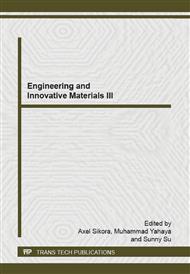p.3
p.7
p.12
p.17
p.22
p.27
p.31
p.36
Nano-Yttrium Aluminium Garnet Interfacial Tension and Viscosity for Enhanced Oil Recovery
Abstract:
This paper describes the synthesis of Yttrium Aluminum Garnet (YAG), Y3Al5O12 nanoparticles (NPs) and their application in Enhanced Oil Recovery (EOR). YAG NPs were synthesized by using sol-gel method. These NPs were then synthesized by using Thermal Gravimetric Analysis (TGA), X-Ray Diffraction (XRD) and Transmission Electron Microscope (TEM). The monophasic YAG having crystallites size of 40.98 nm and 40.91 nm were obtained at annealed temperature of 1100 °C and 1200 °C as determined by XRD. Magnetic measurement results show that initial permeability of YAG increased and relative loss factor decreased at high frequency. In this paper, the feasibility of application of YAG nanofluid in EOR was determined by measuring oil-nanofluid interfacial tension and also viscosity of the nanofluid. YAG with 0.5 wt% yielded the lowest IFT. It can be concluded that the synthesized YAG nanoparticle has great potential in EOR applications in the near future.
Info:
Periodical:
Pages:
3-6
Citation:
Online since:
October 2014
Authors:
Price:
Сopyright:
© 2014 Trans Tech Publications Ltd. All Rights Reserved
Share:
Citation:


